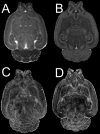The translational role of diffusion tensor image analysis in animal models of developmental pathologies
- PMID: 22627095
- PMCID: PMC3566876
- DOI: 10.1159/000336825
The translational role of diffusion tensor image analysis in animal models of developmental pathologies
Abstract
Diffusion tensor magnetic resonance imaging (DTI) has proven itself a powerful technique for clinical investigation of the neurobiological targets and mechanisms underlying developmental pathologies. The success of DTI in clinical studies has demonstrated its great potential for understanding translational animal models of clinical disorders, and preclinical animal researchers are beginning to embrace this new technology to study developmental pathologies. In animal models, genetics can be effectively controlled, drugs consistently administered, subject compliance ensured, and image acquisition times dramatically increased to reduce between-subject variability and improve image quality. When pairing these strengths with the many positive attributes of DTI, such as the ability to investigate microstructural brain organization and connectivity, it becomes possible to delve deeper into the study of both normal and abnormal development. The purpose of this review is to provide new preclinical investigators with an introductory source of information about the analysis of data resulting from small animal DTI studies to facilitate the translation of these studies to clinical data. In addition to an in-depth review of translational analysis techniques, we present a number of relevant clinical and animal studies using DTI to investigate developmental insults in order to further illustrate techniques and to highlight where small animal DTI could potentially provide a wealth of translational data to inform clinical researchers.
Copyright © 2012 S. Karger AG, Basel.
Figures




Similar articles
-
The diffusion tensor imaging (DTI) component of the NIH MRI study of normal brain development (PedsDTI).Neuroimage. 2016 Jan 1;124(Pt B):1125-1130. doi: 10.1016/j.neuroimage.2015.05.083. Epub 2015 Jun 3. Neuroimage. 2016. PMID: 26048622 Free PMC article.
-
Diffusion tensor imaging analysis for psychiatric disorders.Magn Reson Med Sci. 2013;12(3):153-9. doi: 10.2463/mrms.2012-0082. Epub 2013 Jul 12. Magn Reson Med Sci. 2013. PMID: 23857149 Review.
-
Diffusion tensor imaging for evaluation of the childhood brain and pediatric white matter disorders.Neuroimaging Clin N Am. 2011 Feb;21(1):179-89, ix. doi: 10.1016/j.nic.2011.02.005. Neuroimaging Clin N Am. 2011. PMID: 21477757 Review.
-
In vivo DTI tractography of the rat brain: an atlas of the main tracts in Paxinos space with histological comparison.Magn Reson Imaging. 2015 Apr;33(3):296-303. doi: 10.1016/j.mri.2014.11.001. Epub 2014 Dec 5. Magn Reson Imaging. 2015. PMID: 25482578
-
Diffusion tensor imaging and its application to neuropsychiatric disorders.Harv Rev Psychiatry. 2002 Nov-Dec;10(6):324-36. doi: 10.1080/10673220216231. Harv Rev Psychiatry. 2002. PMID: 12485979 Free PMC article. Review.
Cited by
-
3-dimensional diffusion tensor imaging (DTI) atlas of the rat brain.PLoS One. 2013 Jul 5;8(7):e67334. doi: 10.1371/journal.pone.0067334. Print 2013. PLoS One. 2013. PMID: 23861758 Free PMC article.
-
Excitatory Synaptic Drive and Feedforward Inhibition in the Hippocampal CA3 Circuit Are Regulated by SynCAM 1.J Neurosci. 2016 Jul 13;36(28):7464-75. doi: 10.1523/JNEUROSCI.0189-16.2016. J Neurosci. 2016. PMID: 27413156 Free PMC article.
-
In vivo Diffusion Tensor Magnetic Resonance Tractography of the Sheep Brain: An Atlas of the Ovine White Matter Fiber Bundles.Front Vet Sci. 2019 Oct 16;6:345. doi: 10.3389/fvets.2019.00345. eCollection 2019. Front Vet Sci. 2019. PMID: 31681805 Free PMC article.
-
Diffusion tensor imaging reveals adolescent binge ethanol-induced brain structural integrity alterations in adult rats that correlate with behavioral dysfunction.Addict Biol. 2016 Jul;21(4):939-53. doi: 10.1111/adb.12232. Epub 2015 Feb 11. Addict Biol. 2016. PMID: 25678360 Free PMC article.
-
The neural circuitry of restricted repetitive behavior: Magnetic resonance imaging in neurodevelopmental disorders and animal models.Neurosci Biobehav Rev. 2018 Sep;92:152-171. doi: 10.1016/j.neubiorev.2018.05.022. Epub 2018 May 23. Neurosci Biobehav Rev. 2018. PMID: 29802854 Free PMC article. Review.
References
-
- Le Bihan D, Breton E. Imagerie de diffusion in-vivo par resonance magnetique nucleaire. C R Acad Sci. 1985;301(15):1109–1112.
-
- Johansen-Berg H, Behrens T, editors. Diffusion MRI: From quantitative measurement to in-vivo neuroanatomy. Academic Press; Amsterdam: 2009.
Publication types
MeSH terms
Grants and funding
LinkOut - more resources
Full Text Sources
Medical

